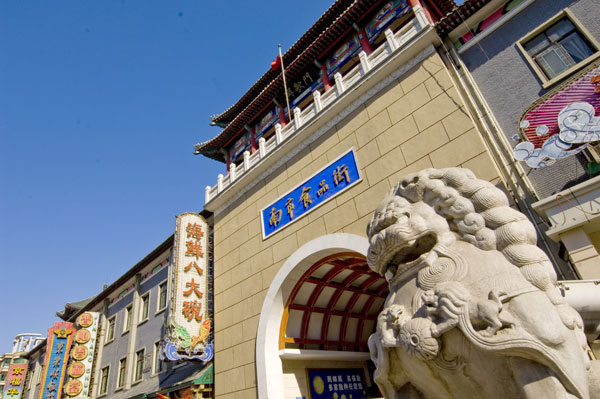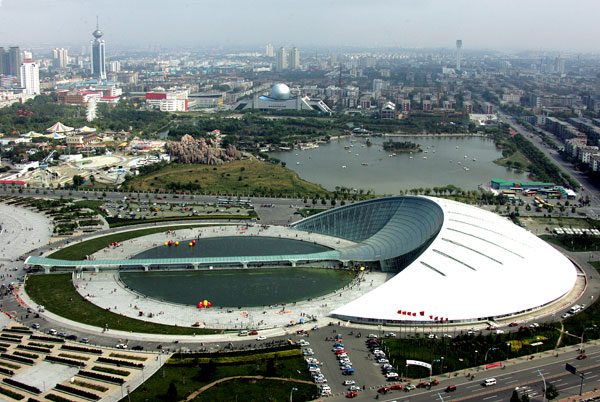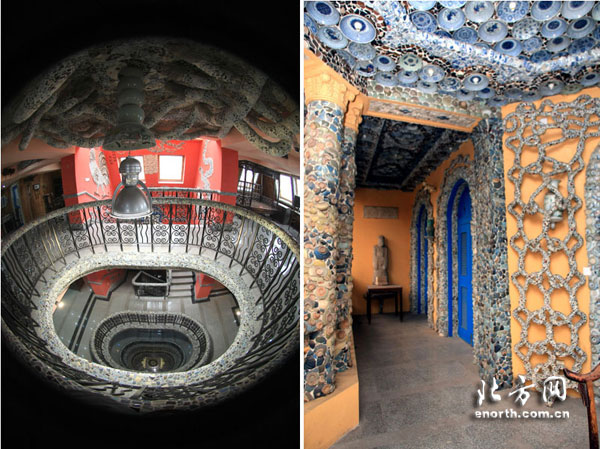Tianjin boasts numerous renowned streets, such as Hepinglu Golden Street and Nanshi Food Street, full of Tianjin commercial tastes; various modern urban amusement places, such as TV & Radio Tower and Water Park, creating a modern urban leisure environment; the cultural museums, represented by the Memorial to Zhou Enlai and Deng Yingchao, exhibiting profound culture of Tianjin.
Recommended Routes:
1st day: Visit Nanshi Food Street——Visit Gulou Commercial & Sightseeing Pedestrian Street, Guangdong Guild Hall——Visit Nankai High School——Visit Hepinglu Golden Street
2nd day: Visit Tianjin Museum——Visit Tianjin Olympic Center Stadium——Visit Water Park, Tianjin Zoo, Tianjin TV & Radio Tower——Visit The Memorial to Zhou Enlai and Deng Yingchao
Tianjin Old Urban Museum: Located at Guloudong Street, it’s a museum showing the ancient culture of Tianjin. It was originally the residence of Xu Pu’an, comprador of the Chartered Bank of India, Australia and China of British. It was built at the end of Qing Dynasty and beginning of Republic of China with elegant and exquisite architecture and decoration. Its principal yard consists of a Siheyuan (quadrangle) with three parts at the center and many sets of fl anking yards. The west chamber has been restored in the style of the typical living room in Tianjin. There are models of ancient city, exhibition of modern Tianjin wedding ceremony, modern living architecture and brick sculpture, folk custom exhibition, etc. in the museum, together with over 3,600 pieces of relics donated by public. It is now a national 3A class tourist site.
Hepinglu Golden Street: Located at west of Haihe River, starting from Bohai Building in the south, and extending to Dongnanjiao in the north, it’s one of the top ten China Famous Commercial Streets. The commercial street of Heping Road connects with Binjiang Road to be a Golden Cross, forming the busiest commercial zone. Buildings at its two sides boast western styles, in which Quanyechang, Huizhong Restaurant, Transportation Restaurant and Guomin Restaurant are of one hundred years old. 2003 saw the rebuilding of European style street lights, ground surface and seats. There are not only ancient China brands inheriting for hundred years, but also boutiques of international fashionable brands here. It’s an ideal choice of touring, leisure, shopping and entertainment.

Nanshi Food Street: Located at Nanshi commercial area of Tianjin city proper, it’s a gathering place of Tianjin restaurants. It collects hundreds of varied yummy meals, not only authentic Tianjin foods and specialties, but also special food systems of other places of China; not only imperial meals in palace enjoying established fame, but also common meals with farmer tastes; not only Muslim meals, but also western foods. Tourists will feel like being in a delicacy kingdom when visiting Nanshi Food Street. The buildings at the street are in ethnical styles. There are carved girders and ridgepoles, turnup roofs and round arcs, four gates connected with each other on the street, with glass roofs connected into a cross shopping zone, just like a palace full of ancient color and taste.
Gulou Commercial & Sightseeing Pedestrian Street: Located at the center of the old city region of Tianjin, it’s a pedestrian street gathering touring, shopping, culture and leisure. The street block is centered by Gulou, extending to east and west and to south and north, forming a cross. It has been built twice and put down twice in history. The latest rebuilding was completed in 2001. The whole pedestrian street features construction styles of Ming and Qing Dynasties.
Water Park: Located at southwest of Nankai District, it’s the largest comprehensive park of Tianjin, a national 4A class touring sight, titled Floating Greens on Dragon Pool. The whole park consists of three big lakes and nine islands distributed in the lakes, hence the name Water Park. There are various yachts for visitors to ride and enjoy, and the entertaining zone also has large-scale risky and exciting game facilities.
Tianjin TV & Radio Tower: Located at the junction of Zijinshan Road and Weijinnan Road of Hexi District, it combines touring and sightseeing, restaurant, entertainment and broadcasting signal transmission into one entity. The tower is a unique tower surrounded by water at its four sides, with a height of 415.2m. The Tower Foundation Hall, Viewing Hall, Outer Space Rotating Hall and Open Air Viewing Platform are open to tourists.
Tianjin Zoo: Located at Nankai District and adjacent to Water Park, it’s one of the Top Seven Zoos in China. There are over 200 kinds and 3000 animals in the zoo today, including rare species of national first and second class protected animals, Giant Pandas, Red Pandas, Siberian Tiger , Golden Monkey, Red-crowned Crane, etc., as well as rare animals from overseas, such as American Tiger, African Lion, Polar Bear and Macaw, etc.

Tianjin Olympic Center Stadium: Located at the crossroad of Binshuixi Road and Shuishanggongyuandong Road, Tianjin Olympic Center Stadium was built near water, forming a unique stadium in water in the world, and was known as Dropping Water for its exterior shape. It was a branch game place of the FIFA Women’s World Cup 2007 and the Football Game of 2008 Beijing Olympic Games, and also held the two games of preliminary games of Asia area for FIFA 2010 South Africa World Cup.
The Memorial to Zhou Enlai and Deng Yingchao: Located at 1 Shuishanggongyuanbei Road, Nankai District, it was built in memory of the couple of Zhou Enlai and Deng Yingchao, and opened in 1998. Comrade Jiang Zemin inscribed the name for the Memorial. It has Viewing Hall, Life Hall, Cultural Relics Library and Literature Information Center, etc., accommodating up to ten thousand of literatures and pictures, as well as hundreds of precious articles. The original scene of Xihua Hall at Zhongnanhai, where Zhou Enlai and Deng Yingchao once worked and lived, reappeared in 2008, exhibiting not only the original sight of Xihua Hall of Zhongnanhai during the 1950’s to 1960’s, but also many articles that Premier Zhou once used.
Nankai High School: Located at 22 Nankaisimalu Road, Nankai District, it was founded in 1904 by Yan Xiu and Zhang Boling, two famous educators. It was the cradle of Nankai series schools, and was designated as key national high school by the Ministry of Education in 1978. In one hundred years Nankai fostered two premiers and ten thousand graduates. Now the classrooms and dormitories where the two premiers of P.R. China, Zhou Enlai and Wen Jiabao, once studied and lived, were still preserved. Premier Wen Jiabao’s inscription for his mother school—Nankai Will Be Young For Ever—is now hanging inside the Xiangyu Building of Nankai High School.
Tianjin Natural History Museum: Located at 206 Machang Road, Hexi District, it was approved as national A class museum, a comprehensive museum incorporating many fi elds, e.g, animals, plants, paleontologic and geological lives, etc. It accommodates nearly 400 thousand pieces of specimen of animals and plants, as well as fossils of paleontology and palaeoanthropology, ranking the fi rst of such in China. Ocean World Hall was newly added here in 2004, presenting fish and other marine lives.
Tianjin Science and Technology Museum: Located at Longchang Road, Hexi District, it’s a national 3A class touring sight and scientific education base. With a fl oor area of 30,000 m2 and a building area of 21,000 m2, it was formally opened to the public in 1995. Mr. Shiingshen Chern, the late international mathematician and American Chinese, had been honor director. There are 12 halls exhibiting over 300 pieces (sets),above 90% being operable. Its main global building, Universe Opera, features 360° sphere movie showing equipment and digital electric planetarium system, is the only theatre with planetarium function in China mainland till now. The collections at the museum integrate science, knowledge, fun, participation and art into one entity, introducing scientifi c and technological knowledge vividly by modern means, such as sound, light, electricity and computer, thus tourists may participate in the operation and experience the fun of science and technology.

Tianjin Museum: Located at Yinhe Square, Hexi District, it’s a large scale comprehensive cultural museum & touring site, integrating cultural relics collection, protection, study, education and entertainment into one entity. The museum looks like a swan going to fl y in exterior shape, with smooth lines, and it’s full of elements of times and art. It accommodates over 200 thousand pieces of relics, including unearthed, inherited relics and folk craftwork, such as oracle bones, bronze wares, potteries, porcelain, jade, royal seals, inkstones, paintings and books, antique money coins, stamps, etc., among which nearly one thousand pieces are national fi rst class cultural relics.
Guangdong Guild Hall: Located at south of Gulou of the old city of Tianjin, it was built in the 29th year of Guangxu Period, Qing Dynasty(1903). It’s the only guild building of Qing Dynasty with the largest scale and most elaborate decoration in Tianjin till now. It has become Tianjin Theatre Museum, a national cultural protected unit. Sun Yat-Sen once visited here to give a lecture in 1912. The Theatre Hall is its main building, a wood structure rare in China. There are three exhibition halls in the museum, presenting over 4,000 pieces of articles and collections related with the theatre.
Huayun Museum: Located at Hebei Road, Heping District, it was built in 1937, designed by an Italian architect, the fi rst private museum in Tianjin, and a cultural protection unit, whose principal building is named Gedalou. Ma Lianliang, the peking opera master, once lived here. The museum exhibits over 100 kinds, over 3,000 pieces cultural relics, including typical wares of various historical periods from Xizhou to Qing Dynasty of China history, e.g., bronze wares, porcelain, wood sculptures, stone sculptures as well as white marbles of Beiqi, Beiwei, Song, Yuan, Ming and Qing Dynasties. It’s named Huayun Museum, to describe the profound ancient cultural essence of China. Now in the museum there is a special restaurant of Guangdong style, and it is thus known as Edible Museum.

Porcelain House: Located at Chifeng Road, Heping District, this Antique Porcelain Museum was elaborately built over six years on the base of a French-style building. There are over 4,000 pieces ancient porcelain wares, over 400 pieces of white marble sculptures, over 20 tons of crystals and carnelians as well as tens of thousands of porcelain pieces. The museum collects essences of various dynasties, e.g., celadon porcelain of Jin Dynasty, Tang Tri-Color pottery of Tang Dynasty, Jun Porcelain and Longquan Porcelain of Song Dynasty, Blue and White Porcelain of Yuan Dynasty and Ming Dynasty, as well as Famille Rose Porcelain of Qing Dynasty. Its exterior wall is decorated with over six hundred ancient porcelain vases, and is named as Safety Wall.
Mazu Temple: Located at the center of Ancient Culture Street, west of Sancha Hekou, it was built in Yuan Dynasty, and is the oldest temple well preserved till now. Mazu Temple at Tianjin, together with Mazu Temple at Meizhou, Fujian Province, and Chaotian Palace at Beigang, Taiwan, are Top Three Mazu Temples in the world. It is also a center of Mazu culture research in north China, attracting from all over attention.The Tianjin History Exhibition and Tianjin Folk Custom Exhibition in the palace introduce the formation and development of Tianjin, Tianjin shipping history, Mazu belief custom, Tianjin folk custom and seasonable culture.
Folk-custom Community Center: Located at south of Ancient Culture Street, Nankai District, it has a total building area of over 3,000 m2. It mainly introduces unique and special folk custom of Tianjin festival, commercial and wedding custom, etc., during the 1920’s and 1930’s through 1970’s and 1980’s, thus tourists can learn about life custom and status of Tianjin people at that time.
Museum of Mazu Temple of Yuan-Ming-Qing Dynasties: Located at Dazhiguzhong Road, Hedong District, it’s a historical museum showing ancient construction sites, Mazu belief phenomenon and its culture formation and process as well as Tianjin urban formation and development history. The establishment of the Dazhigu Tianfei Lingci Palace, the fi rst Mazu temple of north China, was over 100 years earlier than the establishment of Tianjin guard city which was built in the 2nd Year of Yongle Period of Ming Dynasty (1404). The central hall, its principalbuilding, is showing the construction foundation site of Yuan Dynasty, unearthed by archaeologists, as well as Tianfei Palace Grand Hall Foundation Site of Ming Dynasty and Qing Dynasty. The palace exhibits over 200 pieces of relics and over 300 pictures found in the site, divided into four sections, i.e., Profound Ocean, Magic Mazu, City of River and Sea as well as Eternal Site.
Confucian Temple Museum: Located at Dongmenli Street, Nankai District, also called Kongmiao Temple, it’s a place for respecting and rememberingConfucius, and also an education place of Tianjin. It was built in the fi rst year of Zhengtong Period, Ming Dynasty (1436), with a fl oor area of 15,000 m2, consisting of two paralleled temples, i.e., Province Temple and County Temple, as well as Minglun Hall. It’s the only well preserved building complex of Ming and Qing Dynasties with the largest scale. There are reproduced exhibition of the Great Hall of Confucius Temple and Exhibition of Confucius’s life in the museum. The periodically held Sacrifying Confucius Event & Instrumental Theme Performance has become a touring culture brand with profound infl uence.
|